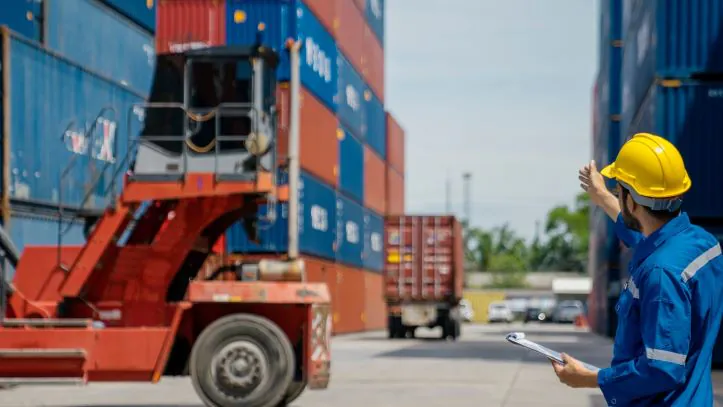Load Planner Software For Intermodal & International Cargo
In today’s fast-paced global trade environment, smart cargo loading is no longer optional; it’s a competitive necessity. Discover how digital load planning tools are reshaping international shipping and helping companies cut costs, streamline operations, and stay agile across complex intermodal networks.

Supply chain transformation in the digital age
Supply chain management is undergoing a deep transformation, driven by the rapid development of digital technologies. While just over a quarter of supply chain companies currently use advanced digital solutions, leading sectors like automotive and electronics show adoption rates of 41% and 45% respectively. This shift is not incremental; it represents a fundamental change in how goods are transported and managed globally.
In 2020, under the banner of Industry 4.0, many supply chain organizations committed up to 5% of their annual revenues to technological advancements. This investment path reflects the demand for greater efficiency, transparency, and real-time tracking throughout the supply chain, especially.
At the same time, ongoing consolidation in the container shipping industry is pushing further toward efficiency. Major players such as Maersk, MSC, COSCO, and CMA CGM have expanded their market share. Over the past 20 years, the top five carriers increased their combined TEU capacity share to 64%. This consolidation requires more sophisticated load planning strategies to fully utilize vessel capacity and minimize transit times, ultimately reducing costs across a globally distributed network.
The role of load planning
In this article, we’ll explore how digital advancements are transforming freight planning. You’ll gain insights into what offers unparalleled control over complex logistics networks.
What is load planning?
The impact of efficient load planning, particularly in container shipping, is undeniable. Containers now carry 23% of dry seaborne trade and nearly all everyday goods like TVs, toys, and clothing. While top performers in freight forwarding and logistics see average returns of 14% and container terminals at 11%, container liners often face tighter margins.

Success in this highly competitive space often depends on achieving significant operational scale. That starts with load planning, ideally handled through a single, integrated system.
Load planning is the process of organizing and arranging goods in a vehicle, be it a truck, container, ship, or plane, to:
- Maximize available space
- Ensure cargo stability and safety
- Minimize costs
- Enable efficient, on-time deliveries
Key aspects of load planning
Maximizing Space Utilization (Cube Out): Fit as much cargo as possible into available space while respecting weight limits. This involves optimizing the placement of items based on their dimensions and using techniques like stacking and interlocking. Advanced software often provides 3D visualization to support this process.
Weight Distribution (Weight Out): Properly distribute weight for vehicle safety and legal compliance. Uneven loads can lead to fines, accidents, or damage. Load planning ensures even axle load distribution.
Freight Compatibility: Certain goods require special handling. Load planning must consider:
- Fragility
- Hazardous materials (with correct labeling and segregation)
- Temperature control
- Odor contamination prevention
Route and Delivery Sequencing: For multi-stop deliveries, cargo must be arranged in reverse delivery order to streamline unloading.
Compliance with Regulations: Planners must adhere to laws regarding vehicle dimensions, weight limits, and dangerous goods transport.
Cost Reduction: Smart planning reduces trips, saves fuel, and minimizes cargo damage.
Efficiency and Timeliness: Faster loading/unloading and improved delivery reliability stem from effective planning.
Technology Integration: Modern logistics rely on digital tools that:
- Analyze item data
- Generate optimal 3D load plans
- Account for constraints and rules
- Integrate with TMS/WMS systems
Why do supply chain companies need a container load planner software?
As of January 2025, the global container trade elaboration made by DHL reported a strong growth of 11.2%. It signals a potentially good year for the shipping industry. However, this initial growth has been met with caution from leading maritime analysis firms Linerlytica and Drewry. Note that both firms have revised their forecasts, predicting a 1.1% decline in global container throughput by year-end.

This shift from growth to projected decline underscores the volatile and unpredictable nature of the global supply chain. In such a volatile landscape, optimizing every aspect of logistics becomes crucial. That’s why supply chain companies need container load planning software.
Here’s why:
- Saves Space and Money: A container load planning software precisely places items, maximizing cargo space and reducing transportation costs by optimizing weight distribution while also adhering to constraints.
- Boosts Efficiency: Automated calculations significantly reduce manual planning time, freeing up your team and streamlining your logistics.
- Improves Visualization and Collaboration: Interactive 3D views make load plans clear, simplifying communication and reducing errors for everyone involved.
- Seamless Integration: Software can easily link with existing systems, such as Excel and ERPs, streamlining data flow while also enhancing overall operational efficiency.
- Handles Complex Loads: From varied item types to specific stacking rules, advanced planners tackle challenging scenarios with ease, ensuring every load is optimized for maximum efficiency.
Load planning in Logistics 4.0: Key challenges
The rise of Logistics 4.0 brings many benefits, but also challenges:
- Disconnected Systems: A core hurdle is the fragmentation of existing systems (WMS, TMS, ERP), which may not share real-time data on inventory, vehicle capacities, or shipment details seamlessly.
- Incompatibility: Automated load planning systems must be able to account for varying package shapes, sizes, and characteristics, while also integrating seamlessly with diverse warehouse robotics and transport automation systems.
- Data Security & Integrity: As load planning becomes more reliant on shared real-time data (from IoT sensors and external partners), ensuring the security and integrity of this sensitive information is paramount.
- Need for Specialized Training: Implementing sophisticated 3D load planning software and AI-driven optimization tools requires significant training for load planners. Their role shifts from manual, experiential arrangement to interpreting complex data, validating AI suggestions, and managing exceptions.
- Achieving Optimal Balance: Logistics 4.0 aims for a „perfect balance between automation and mechanization.” For load planning, this means ensuring the automated system truly maximizes space and distributes weight correctly.
- Dynamic Network Management: The vision of a „big brain” sharing real-time information across all stakeholders offers immense potential for optimized load planning (e.g., dynamic re-planning based on real-time demand shifts).
- Customization vs. Off-the-Shelf: As highlighted, „off-the-shelf tools often fail to cover unique business needs.” It is particularly critical for load planning, where unique package characteristics, specific stacking rules, or complex multi-stop routes demand tailored solutions that generic software might not provide.
Conclusion: Planning for a smarter supply chain
Global logistics is transforming rapidly. Sophisticated load planning has become essential, not just beneficial.

Whether it is overcoming disconnected systems and incompatible packages to tackling the need for specialized training and dynamic network management, the challenges of Logistics 4.0 are real. However, the solutions offered by modern load planning software directly address these hurdles, enabling businesses to unlock unparalleled levels of efficiency, cost reduction, and operational control.
Take the next step with EasyCargo
Don’t let your valuable cargo space go to waste or complex logistics slow you down. EasyCargo offers a cutting-edge solution designed to meet these exact needs:
- Save Space and Money: Precisely optimize every load to cut transportation costs and improve your bottom line.
- Boost Efficiency: Automate complex calculations, freeing your team to focus on strategic tasks.
- Improve Visualization and Collaboration: Leverage intuitive 3D views for clear planning and seamless communication.
- Seamlessly Integrate: Connect with your existing systems (like Excel and ERPs) for a streamlined workflow.
- Handle Complex Loads: Easily manage items, stacking rules, and multiple drop-offs.
Let’s take a look at your business together and maximize every container you load.




